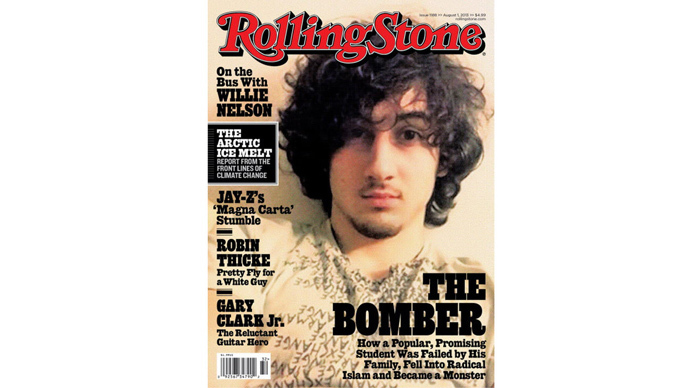Controversial Rolling Stone Tsarnaev cover named ‘Hottest’ of the year

Rolling Stone magazine generated a media firestorm when its editors chose to feature the accused Boston Marathon bomber on its August cover. Partly due to that attention, AdWeek named the issue the "Hottest Cover of the Year" among all magazines.
The advertising trade magazine wrote that the Tsarnaev cover, which featured “The Bomber” in large bold font underneath Tsarnaev’s image, is “hands down the most memorable cover of the year.”
It was the subject of widespread controversy and media sniping before the physical copy even made newsstands. Walmart, Walgreens, Rite Aid, CVS Pharmacy, and a number of national and local chains announced they would not carry the issue out of respect for the victims of the terror attack and their families.
Boston Mayor Tom Menino wrote an open letter to Rolling Stone publisher Jann Wenner, decrying the decision while being careful to note that responding in anger would “feed into your obvious marketing strategy.”
“Your August 3 cover rewards a terrorist with celebrity treatment. It is ill-conceived, at best, and re-affirms a terrible message that destruction gains fame for killers and their ‘causes,’” Menino wrote.
Rolling Stone defended its decision, citing the actual story about Tsarnaev (which was praised for its depth of reporting) and its relevance to the magazine’s audience.
“Our hearts go out to the victims of the Boston Marathon bombing, and our thoughts are always with them and their families,” the editors wrote. “The cover story we are publishing this week falls within the traditions of journalism and Rolling Stone’s long-standing commitment to serious and thoughtful coverage of the most important political and cultural issues of our day.”
“The fact that Dzhokhar Tsarnaev is young, and in the same age group as many of our readers, makes it all the more important for us to examine the complexities of this issue and gain a more complete understanding of how a tragedy like this happens,” the statement continued.
Among those upset was Massachusetts State Police sergeant Sean Murphy. Murphy, who said the cover glorified “the face of terror,” released dramatic images of Tsarnaev during the final moments of the manhunt for the alleged bomber.
He retired from the police upon being charged with unauthorized release of the photos, but not before Boston Magazine published the now-infamous image of Tsarnaev emerging from hiding with a sniper’s red dot on his forehead.
In the days following the controversy, Rolling Stone contributing editor Matt Taibbi explained that readers emailed him to criticize the staff after they had “done a sexy photo shoot for Tsarnaev” and “posed him like Jim Morrison.”
Taibbi agreed that, had that been the case, Rolling Stone would have deserved the backlash. But Tsarnaev had taken that picture of himself before the bombing - it was even used on a Sunday cover of the New York times in May.
“But there was no backlash against the Times, because everyone knows that the Times is a news organization. Not everyone knows that about Rolling Stone,” he wrote.
“As to the question of why anyone would ever put a terrorist on the cover of a magazine for any reason beyond the opportunity to slash a red X through his face or depict him in crosshairs, there’s an explanation for that. Terrorists are a fact of our modern lives and we need to understand them, because understanding is the key to stopping them.”
Sales jumped by 102 percent from Rolling Stone’s August 2012 issue, which featured pop star Justin Bieber on the cover with a “HOT, READY, LEGAL” headline. An analysis conducted by Magazine Information Network examined 1,420 retail stores over a ten-day span, finding that 13,232 copies were sold.
AdWeek noted in its list of “the most sizzling media brands and media people” that the sales numbers proved “again that while sex sells, controversy does too.”














